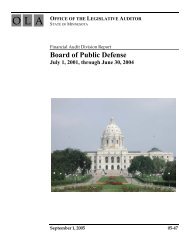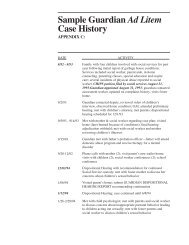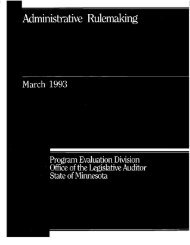Occupational Regulation - Office of the Legislative Auditor
Occupational Regulation - Office of the Legislative Auditor
Occupational Regulation - Office of the Legislative Auditor
Create successful ePaper yourself
Turn your PDF publications into a flip-book with our unique Google optimized e-Paper software.
SUMMARY<br />
xix<br />
include nurses, commercial pesticide applicators, teachers, physicians, and<br />
dentists.<br />
We interviewed <strong>the</strong> executive directors and o<strong>the</strong>r staff <strong>of</strong> five health-related boards<br />
with a relatively high volume <strong>of</strong> complaints to discuss complaint data and to learn<br />
more about <strong>the</strong>ir case-tracking systems and <strong>the</strong> availability <strong>of</strong> data needed for<br />
proper management <strong>of</strong> <strong>the</strong> caseload and for producing <strong>the</strong> type <strong>of</strong> information<br />
legislators and <strong>the</strong> public ought to see. We learned that several <strong>of</strong> <strong>the</strong> boards are<br />
in <strong>the</strong> process <strong>of</strong> developing new information systems, and all recognized to some<br />
degree that <strong>the</strong>ir reporting <strong>of</strong> complaint investigations could be made more useful.<br />
We also learned that <strong>the</strong> Board <strong>of</strong> Dentistry, <strong>the</strong> Board <strong>of</strong> Nursing, and <strong>the</strong> Board<br />
<strong>of</strong> Medical Practice had significantly reduced <strong>the</strong>ir backlogs in recent years.<br />
We also reviewed <strong>the</strong> status <strong>of</strong> investigations that had been referred to <strong>the</strong><br />
Attorney General’s <strong>Office</strong> by <strong>the</strong> boards. The Attorney General investigates about<br />
10 to 15 percent <strong>of</strong> cases filed with <strong>the</strong> health boards and is required to be<br />
involved in all cases alleging sexual misconduct or an active chemical dependency<br />
problem. The purpose <strong>of</strong> <strong>the</strong> Attorney General’s involvement is to assure public<br />
accountability in investigations <strong>of</strong> licensed pr<strong>of</strong>essionals by boards dominated by<br />
pr<strong>of</strong>essionals.<br />
A few years ago, <strong>the</strong> Attorney General’s <strong>Office</strong> was <strong>the</strong> target <strong>of</strong> criticism from<br />
many <strong>of</strong> <strong>the</strong> health boards, because <strong>of</strong> a backlog <strong>of</strong> investigative cases and delays<br />
in <strong>the</strong> investigation and resolution <strong>of</strong> cases. To some extent <strong>the</strong> boards still<br />
complain about <strong>the</strong> time and money <strong>the</strong>y must spend on legal and investigative<br />
services from <strong>the</strong> Attorney General’s <strong>Office</strong>. We inquired about <strong>the</strong> current status<br />
<strong>of</strong> <strong>the</strong> backlog and found:<br />
· The Attorney General’s <strong>Office</strong> has implemented an effective case<br />
tracking system and has made progress in reducing <strong>the</strong> backlog <strong>of</strong><br />
investigative cases that existed a few years ago.<br />
The Attorney<br />
General’s<br />
<strong>Office</strong> has<br />
reduced its<br />
backlog <strong>of</strong> cases<br />
in recent years.<br />
There were 246 investigative cases open in <strong>the</strong> Attorney General’s <strong>Office</strong> at <strong>the</strong><br />
end <strong>of</strong> fiscal year 1995. By <strong>the</strong> end <strong>of</strong> fiscal year 1998, this number had declined<br />
to 170 cases.<br />
Review <strong>of</strong> Existing Programs<br />
In Chapter 214, Minnesota has an explicit policy governing proposals for new<br />
occupational regulation, and statutory statements about <strong>the</strong> purpose <strong>of</strong> regulation<br />
and <strong>the</strong> conditions justifying regulation. It is not clear to what extent <strong>the</strong>se<br />
principles or criteria should apply to existing regulatory programs, many <strong>of</strong> which<br />
were implemented prior to enactment <strong>of</strong> <strong>the</strong> sunrise criteria in 1976. However,<br />
<strong>the</strong>re is a need to periodically re-examine <strong>the</strong> contemporary need for regulatory<br />
programs and <strong>the</strong> Chapter 214 criteria are a useful place to start. Specifically, it is<br />
useful to ask if currently regulated occupations would pose a serious threat to <strong>the</strong><br />
public health or safety if <strong>the</strong>y were not regulated, or if <strong>the</strong> practice <strong>of</strong> an<br />
occupation requires specialized skill or training. (These are two <strong>of</strong> <strong>the</strong> criteria for<br />
occupational regulation articulated by Chapter 214.) It is obvious that <strong>the</strong><br />
application <strong>of</strong> <strong>the</strong>se criteria requires <strong>the</strong> exercise <strong>of</strong> judgment by policy makers<br />
aided by relevant data and information.








